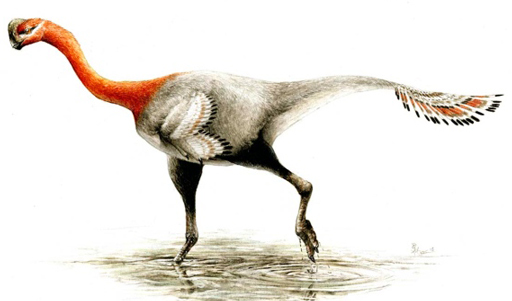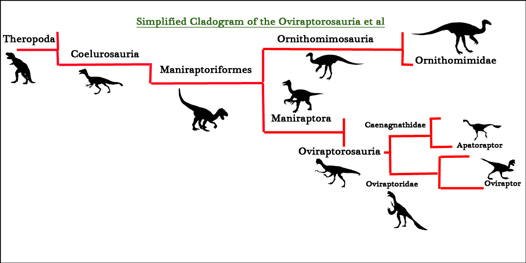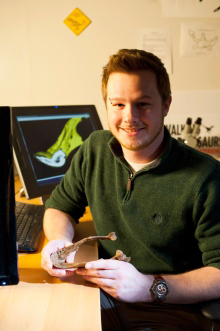Apatoraptor pennatus – Helps to Tie Together the Caenagnathidae
A University of Alberta PhD student working in collaboration with one of the world’s most respected palaeontologists has helped to unravel the connections between a bizarre toothless dinosaur from Alberta and its relatives from Asia. In doing, so student Greg Funston was able to identify a new species of dinosaur, one that would have been at home in the steamy Late Cretaceous swamps that once covered southern Canada. The new dinosaur has been named Apatoraptor pennatus, the genus name means “deceptive speedy thief”, as it was originally mistaken for another, more common dinosaur.
An Illustration of the New Feathered Dinosaur Apatoraptor pennatus

The presence of ulnar papillae on the ulna (bone of the forelimb) indicates the presence of long feathers on the arm.
Picture credit: Sydney Mohr
A near complete and partially articulated dinosaur specimen was discovered in 1993 by a field team exploring strata that makes up the Horseshoe Canyon Formation of southern Alberta. The fossil material consisted of part of the lower jaw (mandible), articulated neck and back bones (cervical and dorsal vertebrae), elements from the forelimbs, a partial ilium (bone from the hip) and parts of the back legs. Gastralia (stomach stones) were also found in association with the fossilised bones. Although no traces of feathers were found with this specimen, marks on the ulna (a bone in the forearm), indicated that this 1.8 metre long dinosaur probably had feathers on its arms.
Misidentified as an Ornithomimidae Member
The fossil was originally thought to represent an ornithomimid (bird-mimic) dinosaur, as several genera of ornithomimid had been reported before (Ornithomimus, Struthiomimus and Dromiceiomimus). As a result, the material was not studied extensively but stored at the Royal Tyrrell Museum (Drumheller, Alberta). Much later the fossil was identified as a member of the Oviraptorosauria, a clade of very bird-like dinosaurs but ones that were not closely related to the ornithomimids – the bird-mimics. Specifically, the fossil was assigned to the Epichirostenotes genus (pronounced Ep-ee-ky-row-sten-oh-tees), a member of the enigmatic Caenagnathidae family.
Student Greg Funston, had the opportunity to conduct research on the bones as part of his PhD thesis and he began to realise that this specimen did not resemble other fossil material assigned to Epichirostenotes that he had examined previously. Greg, with the support and collaboration of his PhD supervisor (Professor Phil Currie), concluded that this was indeed an example of a dinosaur more closely related to Oviraptor than to Ornithomimus, but it was sufficiently different from Epichirostenotes to have a new genus – Apatoraptor erected.
Introducing the Caenagnathidae
The Oviraptorosauria are a clade of dinosaurs very closely related to modern birds. They are part of a much larger group of dinosaurs the Maniraptora, which includes the sickle-toed, clawed “raptors” such as Deinonychus and Velociraptor. The different dinosaur families that make up the Oviraptorosauria are usually split into two groups*:
- Caenagnathidae
- Oviraptoridae
*The classification of the Oviraptorosauria is controversial, most genera are only known from fragmentary remains and exact phylogenetic relationships are difficult to determine.
Caenagnathids (pronounced see-nag-na-fids) differ from oviraptorids in a number of ways. There are differences in the jaws, the skulls tend not to be so deep and the finger proportions are different. These and other subtle anatomical help to distinguish the two families.
A Simplified Cladogram Showing the Phylogenetic Relationship between the Caenagnathidae and the Oviraptoridae
Picture credit: Everything Dinosaur
A Feathered Dinosaur that Probably Liked to Display
A study of the arm bones of Apatoraptor revealed large muscle scars indicating that the relatively short arms were strong. Prominent notches on the ulna (ulnar papillae) suggest that the arms possessed long, quill feathers. Greg concluded that this dinosaur moved its arms quite vigorously, probably some form of display with its long feathered arms, perhaps these displays were used in mate selection or to intimidate potential predators.
Apatoraptor pennatus
As Apatoraptor pennatus fossil material represents the first articulated caenagnathid skeleton from anywhere in the world (meaning the bones are still in the same position as when the animal died) and is by far the most complete caenagnathid skeleton from Alberta. Apatoraptor has helped palaeontologists to understand more about the taxonomic relationships within the Caenagnathidae. It turns out that A. pennatus (the name means deceptive, winged speedy thief), may be more closely related to Asian dinosaurs than to other caenagnathids from North America.
Commenting upon the significance of this research, Greg stated:
“This is my first time naming a new dinosaur. It’s really exciting on a personal level, but what I am most excited about is what it means for this field of palaeontology. In future studies, it will help us to better understand these dinosaurs. It’s a really important specimen, because it is a relatively complete skeleton. it helps resolve the relationships of caenagnathids, which have always been problematic. Most caenagnathids are represented by isolated material or single bones, which means that we can’t tell if they came from the same animal. Apatoraptor gives us a better idea of what these animals looked like, which tells us if the features we have been using to separate species are significant or not.”
Greg Funston with a Model of the Jawbone
Picture credit: University of Alberta
Apatoraptor pennatus – A Prehistoric Heron?
Dating from around 70 million years ago (Maastrichtian faunal stage of the Late Cretaceous), Apatoraptor roamed the swamplands of southern Alberta. The climate was sub-tropical and the region resembled the Florida Everglades of today. It may have waded through shallow water feeding on crustaceans, fish and amphibians as well as grazing on water weeds. It may have resembled a heron as it carefully picked its way through the water. It was likely covered in a coat of shaggy feathers, although it was far to big to be able to fly.
Greg added:
“Oviraptorosaurs, the bigger group to which Apatoraptor and other caenagnathids belong, were probably some of the flashiest dinosaurs. We know of three separate ways—head crests, tail feathers and now arm feathers—that they would display to their mates.”
For models and replicas of feathered dinosaurs: CollectA Age of Dinosaurs Popular Figures.








I hope that CollectA have this on their radar for next year’s models.